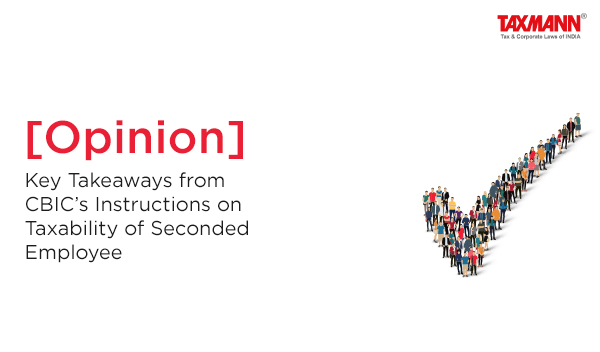[Opinion] Key Takeaways from CBIC’s Instructions on Taxability of Seconded Employee
- News|Blog|GST & Customs|
- 2 Min Read
- By Taxmann
- |
- Last Updated on 18 January, 2024
B. Sairam & S. Sashi Barathvaj – [2024] 158 taxmann.com 394 (Article)
GST authorities are citing the Supreme Court’s judgment in the Northern Operating Systems (NOS) case to raise GST demands on Indian companies’ seconded employees. Companies are thereby concerned about the financial burden and potential Income Tax implications.
Industry representatives have raised concerns about field formations using Section 74(1) in many secondment cases without proper justification. This section allows extended limitation periods for investigating tax evasion cases involving fraud, wilful misstatement, or suppression of facts.
The Central Board of Indirect Taxes and Customs (CBIC) has issued an Instruction No. 05/2023-GST dated 13 December 2023 that clarifies and guides against the mechanical application of Northern Operating Systems (NOS) Judgment and promotes a more individualized approach to secondment taxability under GST.
Background
Multinational companies (MNCs) often send employees to work in their subsidiaries or affiliates in different countries (including India) on temporary assignments (hereinafter referred to as “secondment”).
Secondment arrangements are increasingly used by MNC to leverage expertise and managing operations of their Indian subsidiaries.
Taxability of such arrangements under GST is a contentious issue.
The question arises that arises is whether a seconded employee becomes an employee of the seconded company, and does this affect exigibility to tax?
A bird’s eye-view of the Hon’ble Supreme Court’s judgment in (Northern Operating Systems)
The Hon’ble Supreme court examined whether a secondment contract was a contract of service, employer-employee relationship (not taxable) or a contract for service, independent contractor relationship for tax purpose (taxable).
Key factors considered by the Hon’ble SC were Control over employees (Indian company had significant control despite overseas payroll), Purpose of secondment (specific tasks for Indian company, not general business of foreign company) and Lien on employment (remained with foreign company, not Indian company).
Click Here To Read The Full Article
Disclaimer: The content/information published on the website is only for general information of the user and shall not be construed as legal advice. While the Taxmann has exercised reasonable efforts to ensure the veracity of information/content published, Taxmann shall be under no liability in any manner whatsoever for incorrect information, if any.

Taxmann Publications has a dedicated in-house Research & Editorial Team. This team consists of a team of Chartered Accountants, Company Secretaries, and Lawyers. This team works under the guidance and supervision of editor-in-chief Mr Rakesh Bhargava.
The Research and Editorial Team is responsible for developing reliable and accurate content for the readers. The team follows the six-sigma approach to achieve the benchmark of zero error in its publications and research platforms. The team ensures that the following publication guidelines are thoroughly followed while developing the content:
- The statutory material is obtained only from the authorized and reliable sources
- All the latest developments in the judicial and legislative fields are covered
- Prepare the analytical write-ups on current, controversial, and important issues to help the readers to understand the concept and its implications
- Every content published by Taxmann is complete, accurate and lucid
- All evidence-based statements are supported with proper reference to Section, Circular No., Notification No. or citations
- The golden rules of grammar, style and consistency are thoroughly followed
- Font and size that’s easy to read and remain consistent across all imprint and digital publications are applied








 CA | CS | CMA
CA | CS | CMA


